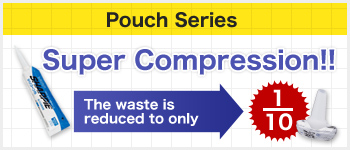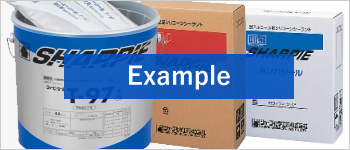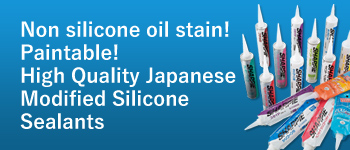-
- Pick Up

-
Frequently Asked Questions
- QI have a one-part modified silicone (MS sealant) which is past its expiration date.
I want to use it since it is unopened, is it okay?
- ABasically, we do not recommend it.
Modified silicones that are past their expiration date may cause a slow surface cure, leaving tack on the surface for a long period of time, and may take a very long time to cure internally. They may also thicken and not be usable as normal.
This is because heat and moisture can alter the catalyst for curing and/or cause it to harden internally after long-term storage.
- QHow much area can a cartridge cover?
- AOur sealants usually store 330ml in a 320ml container. For more information, feel free to contact us.
The general formula is as follows:
area [m] = sealant volume [ml] / ( joint width [mm] * joint depth [mm])
- QWhat materials do I need for a DIY sealing?
- ACartridge gun, a spatula for tooling, and masking tape to mark the border of sealant application.
- QCan I paint on the Silicone series?
- AThe standard silicone sealant such as the SHARPIE SILICONE S is not paintable. The alternative modified silicone (SHARPIE HENSEI M), however, can. Even still, some paints are incompatible. We recommend testing prior to painting. Applying a primer can help with paintability.
- QWhy are my bathroom tiles slippery after I apply a Silicone sealant?
- ASilicone sealants contain silicone oil, which overflows when exposed to water and becomes slippery.
Do not use silicone sealant in large quantities. If only for small repairs, slipperiness should not be a factor.
Using a thinner can temporarily de-slick the sealant.
- QHow do I peel the silicone sealant off?
- ASilicone is very difficult to peel off after curing. If it was used by accident, try to peel it off before it cures.
If it has already cured, you can peel it off by scriber and scrub. Alternatively, you can apply some toluene, then clean it off.
- QWhy do the paints I apply not dry?
- AOil based paints cannot dry in applied on modified silicone and urethane sealants. Other combinations of paints can also be incompatible. We recommend testing prior to painting.
- QI applied some of the Modified Series Sealants a few months ago. Why are the joints’ borders becoming white?
- AWhen a sealant is applied too thinly, it degrades, resulting in discolouration. This problem also occurs for non-modified silicone types. Try to avoid this problem by applying thicker layers of sealant—using masking tape helps to remove the thinly applied sealant on the sides.
- QWhy does the joint sealant have cracks after painting?
- AThe sealant is designed to resist movements from seismic activity, temperature changes, weathering, etc. The paint, however, may not be compatible or elastic enough to match these movements. The paint will crack when the sealant follows the substrates’ movements. To avoid this problem, check the compatibility between the paint and the sealant, especially for movement allowance and followability.
- QCan the Modified silicone series or Urethane series be used in the bathroom?
- ANo. These sealants are not suited for high-temperature nor high-humidity environments. We strongly recommend the non-modified silicone series.
- QWhich sealant is suitable for using on plastics such as polycarbonate, propylene, and ABS?
- ABecause plastics have high vibration resistance and are additionally easy to process, they are becoming more and more commonly used in garages and other areas that require vibration resistance. Using oxime-cure type silicone sealants are liable to cause cracks because of the emission of oxime gas. We recommend non-alcohol types of silicone sealants.
- QWhy is the inner section of an oil based caulk soft?
- AOil based caulks cure with exposure to air. These caulks are used for repairing cracks in reinforced concrete. They are not recommended for moving joints.
- QWhich oil resistant sealant is suitable for preventing water leakage due to rainfall from entering the seal at the bottom of an oil tank between its annular plate and the concrete?
- ATo retain strength even through an earthquake, it must deter rusting between the annular plate and concrete.
Do not use a regular sealant for they usually have low oil resistance and have no effect on rust. We recommend the Tank Seal, which has the highest oil resistance out of all our products. It has been the trusted oil tank seal for the past twenty years.
- QWhy are my environmental type coatings first dry, then become soft and sticky?
- AThis problem does not only occur with environmental type coatings. Depending on the coating, a sealant’s components can be really sensitive. Please consult the coating manufacturer to see if the special environmental coatings contains new components. We also recommend a visibility test. This usually does not occur with single-component Non-Bleed Sealants.
PAGE TOP
























